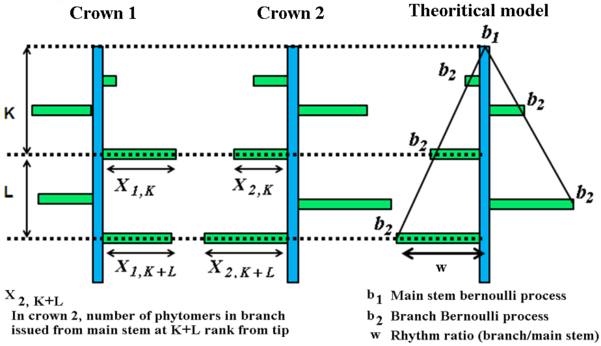Applications
Fitting
Plant structure fitting- Crown Analysis Equations
Crown analysis equations
-
In this section all the main axis phytomers are assumed to branch, and branches are living (no mortality occurs).
In addition to the theoretical conceptual framework, it is also assumed that statistical data are available on the full sets of studied crowns. In more detail, on each crown, those data express the phytomer distribution at rank K from the tip, defined by its expected value and variance. Those statistics relate to their underlying stochastic processes, and we aim to determine their relationships with the crown development parameters.
Let Xi,K be the number of phytomers of the axis at rank K in crown i.
Three parameters, w, b1 and b2 have to be estimated, requiring three statistical values on all the crown data sets.
* Considering rank K first, we can retrieve the expected value and the standard deviation (among the various crowns).
* Then, considering couples of branches at respective ranks K and K+L, the expectation of couple variances in all the crowns specifies intra-crown variance.
These statistical values are expressed here from data sets measured on N crowns, at rank K. Xk stands for the expected value and Vk for the variance at rank K, expressed according to the w, b1 and b2 parameters, whose theoretical values are noted Xk' and Vk', respectively .

Crown analysis data (Image P. de Reffye, CIRAD)
-
Left and middle. Two crowns on which statistics are computed.
Right. Theoretical model to be assessed.
The following relationscan be demonstrated:
-
For inter-crown expected values at rank K:
For inter crown standard deviations at rank K:
The third relation required to estimate the three parameters is given by the intra-crown variance vK defined from couples of branches distant L ranks from K.

We have thus three equations, identifying numerical solutions for the w, b1 and b2 values at rank K.

In practice, small values for L are better for minimizing variances.
L=0 is chosen for plants showing multiple axillaries per node (such as Coffea with an opposite decussate phyllotaxy), and L=1 for plants bearing a single axillary per node (such as cotton trees with alternate phyllotaxy).
